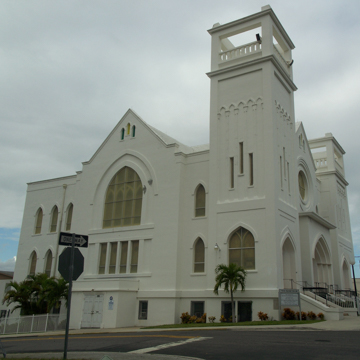The Payne Chapel African Methodist Episcopal (AME) Church was designed in the early 1920s by Hazel Augustus, the first Black registered architect in Palm Beach County and possibly in the State of Florida. While little research has been completed on Augustus’s life, it appears that he was born in Florida, fought in World War I, and was educated as an architect at the University of Pennsylvania before returning to live in the “Northwest Neighborhood” of West Palm Beach, which was the area designated for Black residents. Starting in the late 1910s, Augustus was a successful practitioner, credited with designing the El Verano Hotel (1922), the Tabernacle Baptist Church, and numerous houses (for both Black and White residents) including his own, which was demolished in 1987. While it is unclear exactly when Augustus was born, but he died in a tragic automobile accident in 1926.
Henry Flagler developed the Northwest Neighborhood as a Black settlement to support work on his railroads and hotels. The church was formed in 1893 and by 1895 had moved to First Street and Tamarind Avenue. As the neighborhood for African American settlers expanded north, the church moved to its current location. Augustus began work on the Payne Chapel in 1923. He designed it with concrete foundations and frames for the tower that support red brick walls and a wooden roof. The project seemed to be nearly complete when the architect died and the great hurricane of 1926 blew out the ceiling and destroyed windows and walls. Reconstruction began and the first services were held in 1928; the building dedication occurred in 1929.
The Gothic Revival structure was unusual for West Palm Beach, where most churches were built in the Romanesque style. The church celebrated its verticality by rising eight steps above the street level to the first floor, which afforded a basement below grade. The church is formed by a T-shaped plan, with two towers capped by spare concrete frames on either side of the entrance. To the west of the apse under the extended cross-shaped roof are offices and apartments.
In 1988, the congregation purchased the property surrounding the church building for parking. At the time, the building was also renovated, which included a new roof and interior furnishings as well as the tiling of the foyer and front steps. The interior of the church was gutted and restored following damage sustained during the 2004 and 2005 hurricane seasons. The Payne Chapel continues to serve an active AME congregation.
References
Fields, Dorothy Jenkins. “Tracing Overtown’s Vernacular Architecture.” The Journal of Decorative and Propaganda Arts 23 (1998): 322-333.
“Hazel Augustus–Died in 1926 – A Talent Lost Too Soon.” Palm Beach Post, December 19, 1999.
Taylor, Tulie W., and Beth Miller, “Payne Chapel A.M.E. Church,” Palm Beach, Florida. National Register of Historic Places Inventory–Nomination Form, 1991. National Park Service, U.S. Department of the Interior, Washington, D.C.














